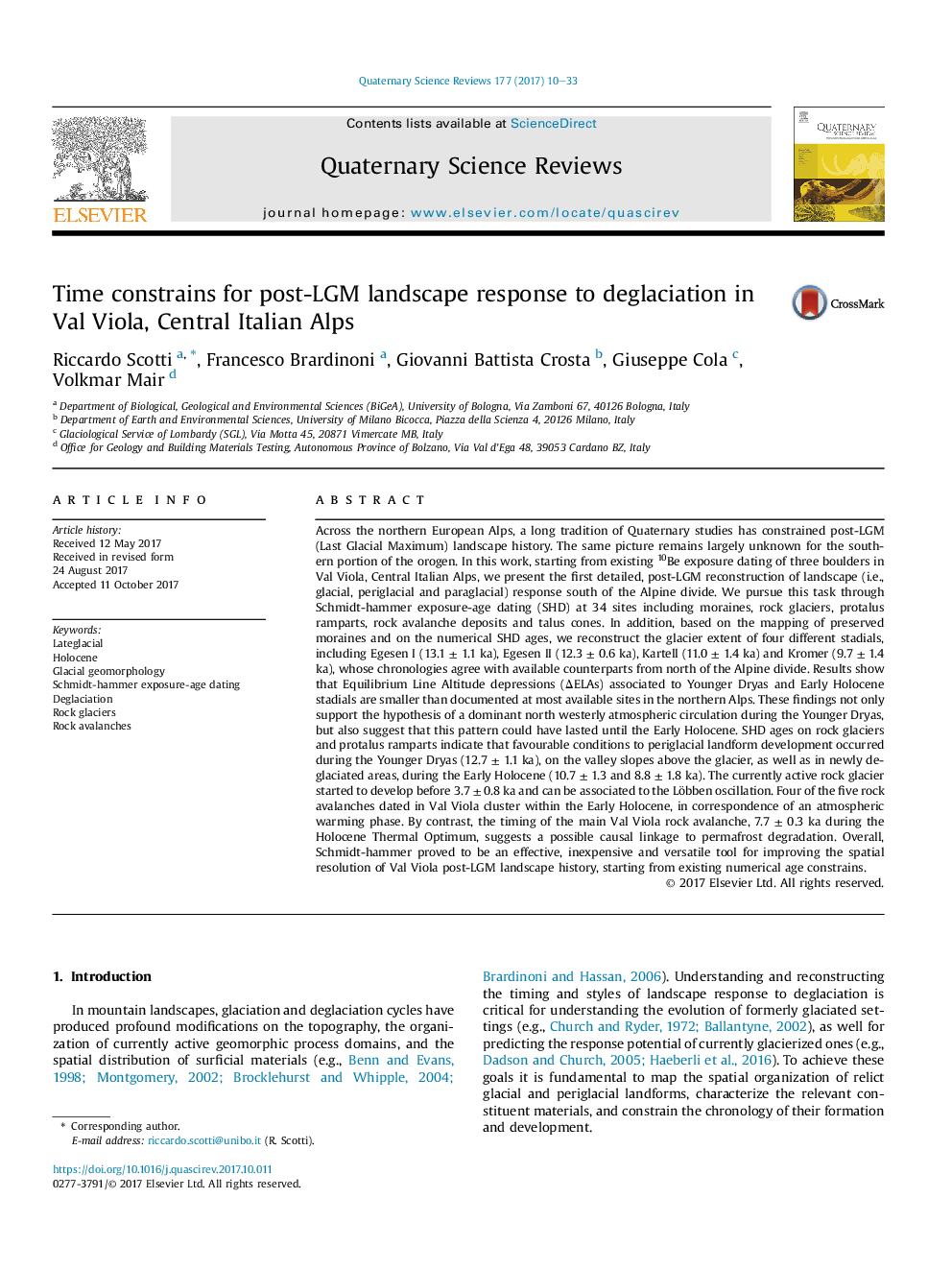| کد مقاله | کد نشریه | سال انتشار | مقاله انگلیسی | نسخه تمام متن |
|---|---|---|---|---|
| 8915078 | 1640758 | 2017 | 24 صفحه PDF | دانلود رایگان |
عنوان انگلیسی مقاله ISI
Time constraints for post-LGM landscape response to deglaciation in Val Viola, Central Italian Alps
دانلود مقاله + سفارش ترجمه
دانلود مقاله ISI انگلیسی
رایگان برای ایرانیان
کلمات کلیدی
موضوعات مرتبط
مهندسی و علوم پایه
علوم زمین و سیارات
زمین شناسی
پیش نمایش صفحه اول مقاله

چکیده انگلیسی
Across the northern European Alps, a long tradition of Quaternary studies has constrained post-LGM (Last Glacial Maximum) landscape history. The same picture remains largely unknown for the southern portion of the orogen. In this work, starting from existing 10Be exposure dating of three boulders in Val Viola, Central Italian Alps, we present the first detailed, post-LGM reconstruction of landscape (i.e., glacial, periglacial and paraglacial) response south of the Alpine divide. We pursue this task through Schmidt-hammer exposure-age dating (SHD) at 34 sites including moraines, rock glaciers, protalus ramparts, rock avalanche deposits and talus cones. In addition, based on the mapping of preserved moraines and on the numerical SHD ages, we reconstruct the glacier extent of four different stadials, including Egesen I (13.1 ± 1.1 ka), Egesen II (12.3 ± 0.6 ka), Kartell (11.0 ± 1.4 ka) and Kromer (9.7 ± 1.4 ka), whose chronologies agree with available counterparts from north of the Alpine divide. Results show that Equilibrium Line Altitude depressions (ÎELAs) associated to Younger Dryas and Early Holocene stadials are smaller than documented at most available sites in the northern Alps. These findings not only support the hypothesis of a dominant north westerly atmospheric circulation during the Younger Dryas, but also suggest that this pattern could have lasted until the Early Holocene. SHD ages on rock glaciers and protalus ramparts indicate that favourable conditions to periglacial landform development occurred during the Younger Dryas (12.7 ± 1.1 ka), on the valley slopes above the glacier, as well as in newly de-glaciated areas, during the Early Holocene (10.7 ± 1.3 and 8.8 ± 1.8 ka). The currently active rock glacier started to develop before 3.7 ± 0.8 ka and can be associated to the Löbben oscillation. Four of the five rock avalanches dated in Val Viola cluster within the Early Holocene, in correspondence of an atmospheric warming phase. By contrast, the timing of the main Val Viola rock avalanche, 7.7 ± 0.3 ka during the Holocene Thermal Optimum, suggests a possible causal linkage to permafrost degradation. Overall, Schmidt-hammer proved to be an effective, inexpensive and versatile tool for improving the spatial resolution of Val Viola post-LGM landscape history, starting from existing numerical age constrains.
ناشر
Database: Elsevier - ScienceDirect (ساینس دایرکت)
Journal: Quaternary Science Reviews - Volume 177, 1 December 2017, Pages 10-33
Journal: Quaternary Science Reviews - Volume 177, 1 December 2017, Pages 10-33
نویسندگان
Riccardo Scotti, Francesco Brardinoni, Giovanni Battista Crosta, Giuseppe Cola, Volkmar Mair,